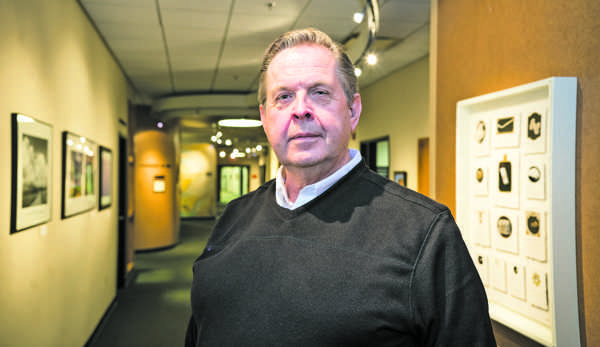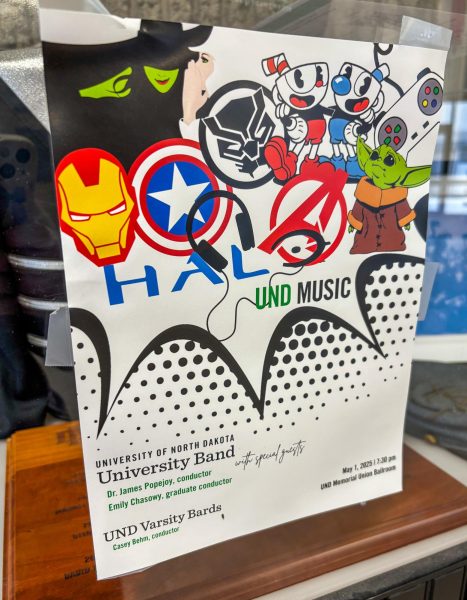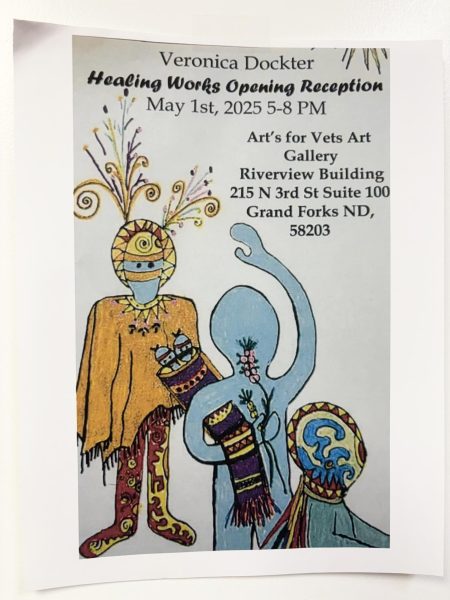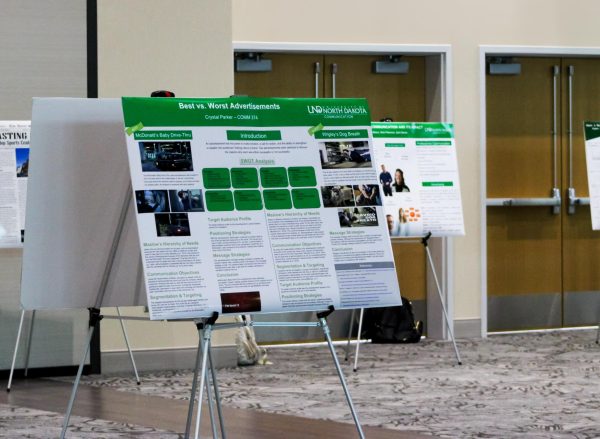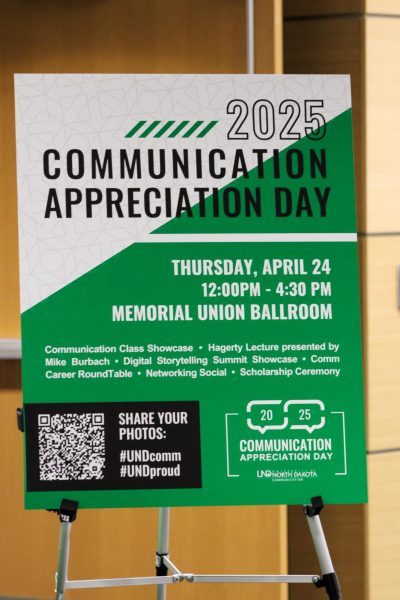Perfecting the art of innovation
Bruce Gjovig stands in a Center for Innovation hallway that displays a few pieces from his art collection. Gjovig started the center, which operates as an outreach center for entrepreneurs, in 1984. Photo by Nick Nelson/The Dakota Student
The UND Center for Innovation makes for an impressive sight on the western edge of campus and has come a long way since its humble beginnings in a closet.
Bruce Gjovig, CEO, director and entrepreneur coach, founded the center in 1984 out of a closet that was once used for storing chemicals in UND’s Harrington Hall.
It is now housed in the Ina Mae Rude Entrepreneur Center and the Skalicky Tech Incubator.
The UND Center for Innovation is an entrepreneur outreach center with the goal of providing assistance to innovators, entrepreneurs and researchers.
In 1984, entrepreneurship was a relatively new phenomenon. Gjovig was one of the pioneers of the industry, with the Center for Innovation being the fourth entrepreneur outreach center in the nation.
A science major at the time, Gjovig studied mathematics, zoology and chemistry. He said the things that drew him to the sciences are likely the same things that drew him to entrepreneurship.
“I really love to build things from scratch,” he said. “That whole process of innovation very much fascinated me, which probably explains my interest in the sciences. I recognized the way that was best expressed for me was through entrepreneurship.”
Along with science and innovation, there’s more than a little art involved in entrepreneurship, according to Gjovig. More than 200 works of art are displayed at the center, around 90 percent of which come from Gjovig’s personal collection. He said this is more than a way to share his collection with many people; it’s a way to inspire innovation.
“Space either can give you energy, or it can suck energy out of you,” he said. “Art is a very important part of fostering and stimulating that innovation and creativity.”
Gjovig’s collection largely consists of pieces from North Dakota and Minnesota artists. Guillermo Guardia, Adam Kemp and David Badman are just a few of the artists with local ties whose art is displayed at the center.
Gjovig worked with Badman while he was a student at UND to make a business out of his art, creating a successful studio. There are connections to be found between entrepreneurship and art, according to Gjovig. He said entrepreneurs and artists have a lot in common.
“They’re very similar in terms of that creative process,” Gjovig said. “They’re keen observers, and that’s how they get their insight.”
Art has the potential to please, challenge or provide new insights, Gjovig said, adding that business ventures work in a similar fashion. The artist and the entrepreneur find something interesting and share their interpretation.
Art and entrepreneurship both require the practitioner to work toward improvement. Gjovig said the Center for Innovation provides a place for entrepreneurs to practice their art.
“Anything that deals with creation or innovation — or the art of business — you have to practice it,” he said. “Practice is absolutely essential to being a top professional.”
The facility is a place for experiential learning and constant professional practice, and students and entrepreneurs should be able to leave its programs with a portfolio of experiences, Gjovig said. He added that a majority of jobs are created by entrepreneurs, and he said he believes many of today’s students will be basically self-employed for the rest of their lives.
This is a good thing, according to Gjovig, who said he believes entrepreneurship has the potential to transform people’s lives.
“Entrepreneurs can be independent, they can build and they can do it the way they want,” he said. “I think that’s a very good skill to have in life, to be captain of your own ship.”
There are more than 30 ventures that call the Center for Innovation home. In addition, there are about 20 student ventures, which ranks among the highest for any university.
The center is closely tied to UND’s School of Entrepreneurship, which is the nation’s second school of entrepreneurship at a public university. Gjovig said the school is changing how entrepreneurship training will be delivered, bringing innovation across the entire campus.
The Center for Innovation gives School of Entrepreneurship students access to the entrepreneur ecosystem, making it a sort of learning laboratory.
Gjovig reminds students that they can be world-class professionals from Grand Forks. The center has world-class facilities — it has been recognized with 15 national and international awards — ready for students with world-class ideas and a work ethic to back them up.
It also is home to the Dakota Venture Group, the nation’s only 100 percent student-run venture capital investment fund.
There are 21 startups related to the unmanned aircraft systems industry affiliated with the center — more than a third are student startups.
The Center for Innovation provides grants to students through the Mueller Entrepreneur Internship program, which encourages students to start businesses before they leave school.
The UND Entrepreneur Professional Practice Program sponsored by Alerus Financial is another option for students. The program pays students to work with startups in the early stages of formation and growth.
Gjovig, who comes from Crosby, N.D., was recently appointed by the U.S. Air Force chief of staff to the Civic Leaders Group, making him one of 35 people worldwide who have been asked to provide advice and input to the Air Force. He was selected specifically for his background in innovation
and entrepreneurship.
Gjovig also was knighted in by Norway’s King Harald V in 2008. He received the Royal Norwegian Order of Merit, given for outstanding service in the interests of Norway. Gjovig has traveled to Norway many times over the past 20 years to work with entrepreneur programs. He also supports an entrepreneur exchange program between the U.S. and Norway.
Lucas Amundson is the features editor for The Dakota Student. He can be reached at lucas.amundson@und.edu


